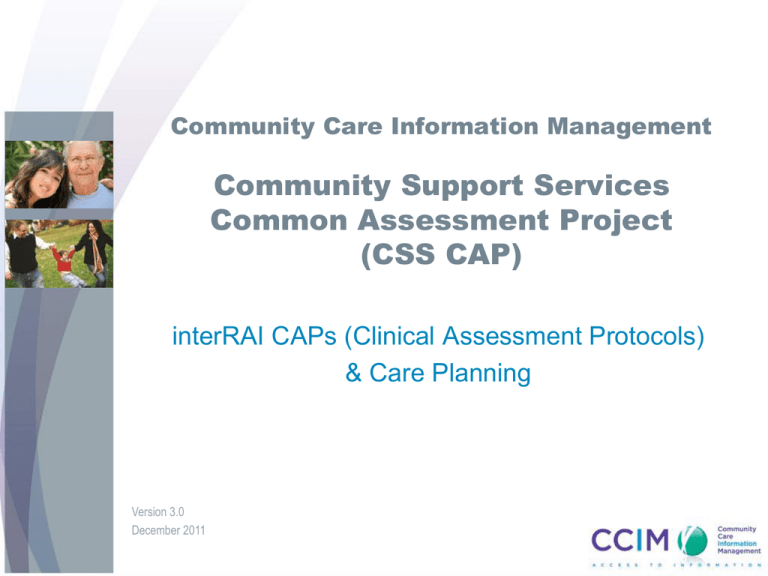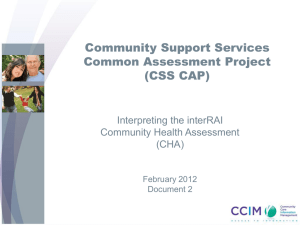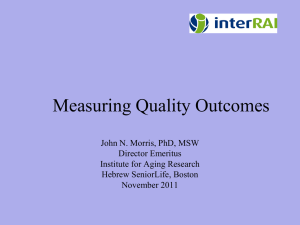03_CAPSCarePlanning_Revamp_20111222_v3
advertisement

Community Care Information Management Community Support Services Common Assessment Project (CSS CAP) interRAI CAPs (Clinical Assessment Protocols) & Care Planning Version 3.0 December 2011 Agenda: CAPs and Care Planning Welcome and Introductions Objectives interRAI Outcome Measures and Scales Introduction to CAPs and Benefits How are CAPs Triggered? Practice Using CAPs Manual Care Planning Break Practice Creating a Care Plan Wrap-up, Evaluations and Q & A 2 Participant Introductions Please introduce yourself – Your name – Your HSP – Your role What is your personal goal in attending this training session? 3 Ice Breaker 4 Education Material Let’s review: – The Assessor Workbook – The interRAI Clinical Assessment Protocols Manual 5 Learning Objectives Upon completion of the CAPs and Care Planning training session you will have increased your understanding about: • How CAPs focus on the client’s function and quality of life, assessing their needs, strengths and preferences • The link between information gathered in the interRAI CHA assessment and the triggered CAPs and Outcome Measures and Scales • How to use CAPs to create a care plan that meets the needs of the client • How CAPs and Outcome Measures and Scales provide the basis for outcome-based assessments and facilitate referrals where appropriate 6 interRAI CHA Outcome Measures and Scales The following outcome measures and scales are generated by your software automatically once the assessment has been completed: Functions of embedded scales: • Evaluate current status of client • Track outcomes of care • Aggregate comparisons for quality benchmarking Adapted with expressed permission from ideas for health, University of Waterloo, June 2010. 7 Available outcome measures: • Cognitive Performance Scale (CPS) • Depression Rating Scale (DRS) • IADL Involvement Scale • Changes in Health, End stage Signs and Symptoms (CHESS) • Pain Scale • Self-Reliance Index (SRI) • ADL Self-Performance Hierarchy Scale • MAPLe interRAI CHA Outcome Measures and Scales: Mr. Patterson Let’s review for Mr. Patterson: • CPS • Pain • MAPLe interRAI CHA Outcome Measures and Scales: Mr. Patterson Let’s review for Mr. Patterson: • CHESS & • MAPLe Clinical Assessment Protocols Structured, problem oriented frameworks to organize information and support care planning Adapted with expressed permission from ideas for health, University of Waterloo, June 2010 10 • Specific clinical characteristics are used to identify clients who could benefit from further evaluation of specific problems either because they are: – at risk for decline or – show potential for improvement • Trigger links to a series of problem oriented assessment protocols • Clinical expertise and choice is important • Not care path/care maps Clinical Assessment Protocols cont’d The CAP report is generated by your software automatically once the assessment has been completed. Key Points About CAPs report: • Generated by software only • Using the information from the Core CHA and Functional Supplement, it identifies key areas that need to be addressed in the following four sections: – Functional performance – Cognition and mental health – Social life – Clinical issues • Each section contains CAPs triggered for a client • Guidelines in the manual help the assessor create the plan of care, provide appropriate service, and/or make timely referrals 11 Benefits of CAPs CAPs: • Enable client’s strengths, needs and preferences to be taken into consideration when developing the care plan • Guide the plan of care to potentially resolve problems, reduce the risk of decline or increase the potential for improvement • Help the assessor to visualize a complete picture of the problem: internal and external factors • Will work with all of the interRAI assessment tools 12 CAPs Throughout interRAI Tools [ i ] interRAI LTCF, not RAI-MDS 2.0 13 CAPs Throughout interRAI Tools (cont’d) [ ii ] interRAI HC, not RAI-HC 2.0 14 CAPs Triggered from Core Assessment Functional Performance: Social Life: • Physical activity promotion • IADL • ADL • Informal support • Social relationships Clinical Issues: Cognition and Mental Health: • Falls • • • • Cognitive loss Communication Mood Abusive relationships Adapted with expressed permission from ideas for Health, University of Waterloo, July 2010. 15 • • • • • • • Pain Cardio-respiratory conditions Dehydration Prevention Appropriate medications Tobacco and alcohol use Urinary incontinence Additional CAPs Triggered When Functional Supplement is Completed Functional Performance: • Home environment optimization • Institutional risk Cognition and Mental Health: • Delirium • Behaviour Adapted with expressed permission from ideas for Health, University of Waterloo, July 2010. 16 Clinical Issues: • • • • Pressure ulcer Undernutrition Feeding tube Bowel conditions How CAPs are triggered CHA Core Assessment Triggers: 1st: G4a – Activity level less than 2 hrs 2nd: G2f- Locomotion-Independent 17 CAPS link the information gathered in the assessment with the goal of problem resolution, reducing the risk of decline or increasing the potential for improvement Physical Activities Promotion CAP How to use the CAPs Manual • Problem (Client Need) • Overall Goals of Care • Triggers • Guidelines (Service Provision) 18 Break 19 From CAPs to Care Planning • All triggered CAPs must be addressed in a care/service plan • Validate triggered CAPs with client to ensure that they are relevant and important • Prioritize triggered CAPs with client for the development of the care plan Adapted with expressed permission from ideas for health, University of Waterloo 20 Putting It All Together 21 Care/Service Planning A Care/Service Plan is: • A communication tool, based on assessment of the client’s care/service needs, is to be used by the care team members • Intended to put measures in to place to prevent decline and manage risk • A collaborative plan of service created with input from client and assessor 22 Characteristics of a Care Plan • Individualized • Current • Accurate • Clear • Relevant • Collaborative 23 Components of a Care Plan DATE TRIGGERED CAP CLIENT NEED (Problem Statement) CLIENT GOAL *Client Needs = Problems in CAPs Manual **Service Provision = Guidelines in CAPs Manual 24 SERVICE PROVISION (Guidelines) RESPONSIBLE PROVIDER REVIEW DATE Let’s practice! • Divide into small groups • Assign a recorder and presenter • Using case study, CAPs Report and CAPs Manual create a care/service plan for the assigned CAP • Share results in the large group 25 Assessment Process Flow Review: phone call or visit to review any aspect of the care/service plan Core CHA Supplements CAPs & Outcome Scales Care Plan Reassessment: face to face comprehensive assessment 26 Review Reassessment Training Resources Education Material • • • • • Project Supports Powerpoint presentations • Website – www.ccim.on.ca Case studies – Electronic copy of all Reference sheets education material Evaluations interRAI CHA CAPs • Support Centre Manual for project-led – csscap@ccim.on.ca sessions – 1-866-909-5600 option 9 • Facilitator binder • Assessor workbook • Supportive calls from project • Certificate of completion 27 Next Steps Electronic Care/Service Planning Next Steps • Certificate of completion signed by facilitator • Let’s sign up for Supported Training - CAPs and Care Planning • Evaluation 29 Wrap-up and Questions Thank you! Project Support Centre Contact Information Email: csscap@ccim.on.ca Toll Free: 1-866-909-5600, option 9 Website: www.ccim.on.ca









